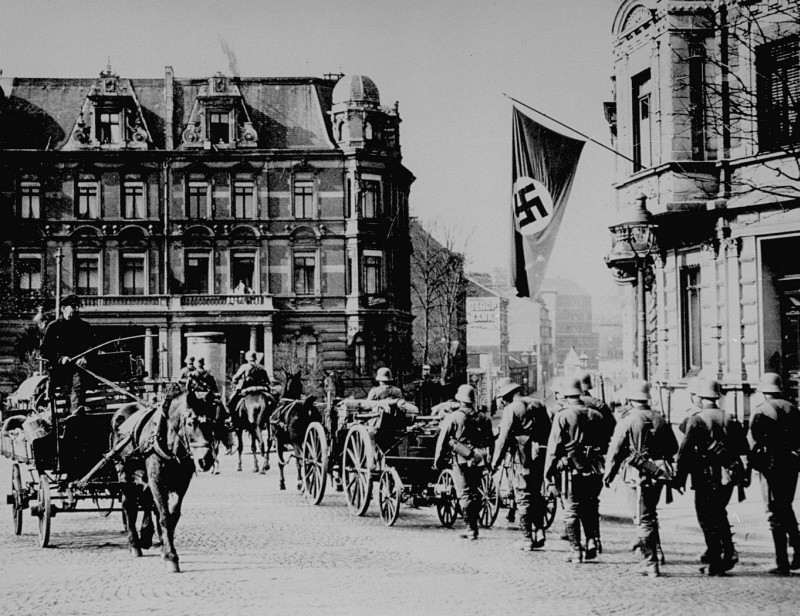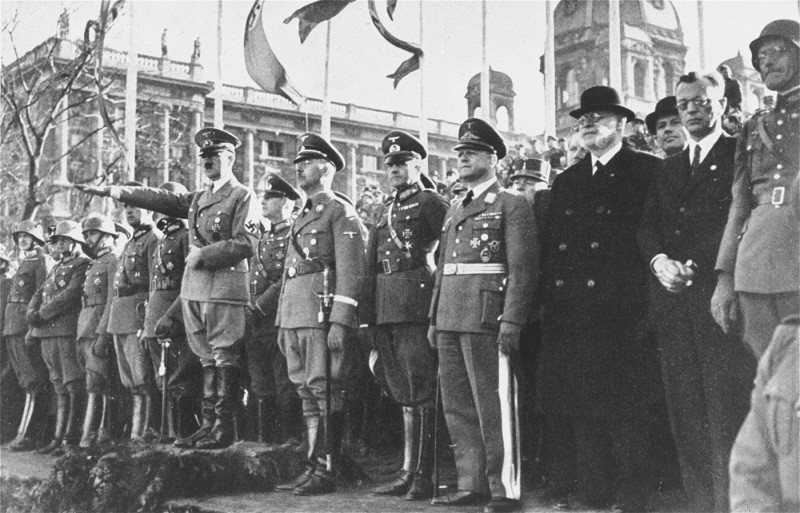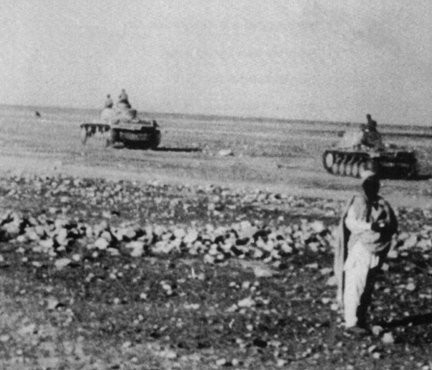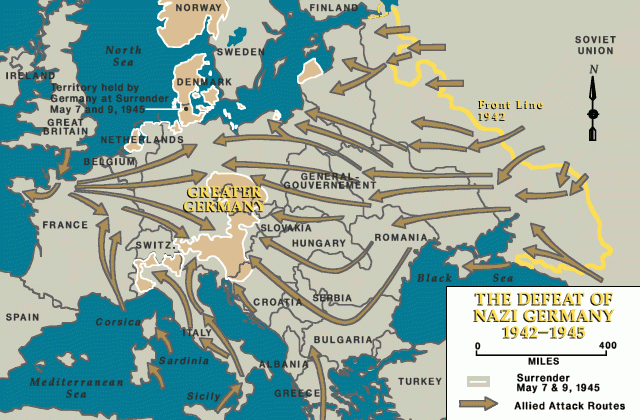
World War II Dates and Timeline
Explore a timeline of key events before and during World War II. The mass murder of Europe’s Jews took place in the context of WWII. As German troops invaded and occupied more and more territory in Europe, the Soviet Union, and North Africa, the regime’s racial and antisemitic policies became more radical, moving from persecution to genocide.
- September 18, 1931 Japan invades Manchuria.
- October 2, 1935–May 1936 Fascist Italy invades, conquers, and annexes Ethiopia.
- October 25–November 1, 1936 Nazi Germany and Fascist Italy sign a treaty of cooperation on October 25. On November 1, the Rome-Berlin Axis is announced.
- November 25, 1936 Nazi Germany and Imperial Japan sign the Anti-Comintern Pact. The pact is directed against the Soviet Union and the international Communist movement.
- July 7, 1937 Japan invades China.
- November 26, 1937 Italy joins Germany and Japan in the Anti-Comintern Pact.
- March 11–13, 1938 Germany incorporates Austria in the Anschluss.

- September 29, 1938 Germany, Italy, Great Britain, and France sign the Munich agreement which forces the Czechoslovak Republic to cede the Sudetenland, including key Czechoslovak military defense positions, to Nazi Germany.
- March 14–15, 1939 Under German pressure, the Slovaks declare their independence and form a Slovak Republic. The Germans occupy the dismantled Czech lands in violation of the Munich agreement and form the Protectorate of Bohemia and Moravia.
- March 31, 1939 France and Great Britain guarantee the integrity of the borders of the Polish state.
- April 7–15, 1939 Fascist Italy invades and annexes Albania.
- August 23, 1939 Nazi Germany and the Soviet Union sign a non-aggression agreement and a secret protocol dividing eastern Europe into spheres of influence.
- September 1, 1939 Germany invades Poland, initiating World War II in Europe.
- September 3, 1939 Honoring their guarantee of Poland’s borders, Great Britain and France declare war on Germany.
- September 17, 1939 The Soviet Union invades Poland from the east. The Polish government flees into exile via Romania, first to France and then later to Great Britain.
- September 27–29, 1939 Warsaw surrenders on September 27. Germany and the Soviet Union divide Poland between them.
- November 30, 1939–March 12, 1940 The Soviet Union invades Finland, initiating the so-called Winter War. The Finns sue for an armistice and cede the northern shores of Lake Ladoga to the Soviet Union. They also cede the small Finnish coastline on the Arctic Sea.
- April 9, 1940–June 9, 1940 Germany invades Denmark and Norway. Denmark surrenders on the day of the attack. Norway holds out until June 9.
- May 10, 1940–June 22, 1940 Germany attacks western Europe, specifically France and the neutral Low Countries (Belgium, the Netherlands, and Luxembourg). Luxembourg is occupied on May 10; the Netherlands surrenders on May 14; and Belgium surrenders on May 28. On June 22, France signs an armistice agreement by which the Germans occupy the northern half of the country and the entire Atlantic coastline. In southern France, a collaborationist regime with its capital in Vichy is established.
- June 10, 1940 Italy enters the war. Italy invades southern France on June 21.
- June 28, 1940 The Soviet Union forces Romania to cede the eastern province of Bessarabia and the northern half of Bukovina to Soviet Ukraine.
- June 14, 1940–August 6, 1940 The Soviet Union occupies the Baltic states (Estonia, Latvia, and Lithuania) on June 14–18. On July 14–15, it engineers Communist coup d’états in each of these countries and then annexes them as Soviet Republics on August 3–6.
- July 10, 1940–October 31, 1940 The air war known as the Battle of Britain ends in defeat for Nazi Germany.
- August 30, 1940 Second Vienna Award: Germany and Italy arbitrate a decision on the division of the disputed province of Transylvania between Romania and Hungary. The loss of northern Transylvania forces Romanian King Carol to abdicate in favor of his son, Michael, and brings to power a dictatorship under General Ion Antonescu.
- September 13, 1940 The Italians invade British-controlled Egypt from Italian-controlled Libya.
- September 27, 1940 Germany, Italy, and Japan sign the Tripartite Pact.
- October 1940 Italy invades Greece from Albania on October 28.
- November 1940 Hungary (November 20), Romania (November 23), and Slovakia (November 24) join the Axis.
- February 1941 The Germans send the Afrika Korps to North Africa to reinforce the faltering Italians.
- March 1, 1941 Bulgaria joins the Axis.
- April 6, 1941–June 1941 Germany, Italy, and Hungary invade Yugoslavia and, together with Bulgaria, dismember it. Yugoslavia surrenders on April 17. Germany and Bulgaria invade Greece in support of the Italians. Resistance in Greece ceases in early June 1941.
- April 10, 1941 The leaders of the terrorist Ustaša movement proclaim the so-called Independent State of Croatia. Recognized immediately by Germany and Italy, the new state includes the province of Bosnia-Herzegovina. Croatia joins the Axis powers formally on June 15, 1941.
- June 22, 1941–November 1941 Nazi Germany and its Axis partners (except Bulgaria) invade the Soviet Union. Finland, seeking redress for the territorial losses in the armistice concluding the so-called Winter War, agrees to participate in the invasion. The Germans quickly overrun the Baltic states and, joined by the Finns, lay siege to Leningrad (St. Petersburg) by September. In the center, the Germans capture Smolensk in early August and drive on Moscow by October. In the south, German and Romanian troops capture Kiev (Kyiv) in September and capture Rostov on the Don River in November.
- December 6, 1941 A Soviet counteroffensive drives the Germans from the Moscow suburbs in chaotic retreat.
- December 7, 1941 Japan bombs Pearl Harbor.
- December 8, 1941 The United States declares war on Japan, entering World War II. Japanese troops land in the Philippines, French Indochina (Vietnam, Laos, Cambodia), and British Singapore. The Japanese occupy the Philippines, Indochina, and Singapore by April 1942 and take control of Burma in May.
- December 11–13, 1941 Nazi Germany and its Axis partners declare war on the United States.
- May 30, 1942–May 1945 The British bomb Köln (Cologne), in the start of a bombing campaign that brings the war home to Germany. Over the next three years Anglo-American bombing reduces urban Germany to rubble.
- June 1942 The US Navy halts the Japanese naval advance in the central Pacific at Midway.
- June 28, 1942–September 1942 Germany and its Axis partners launch a new offensive in the Soviet Union. German troops fight their way into Stalingrad (Volgograd) on the Volga River by mid-September and penetrate deep into the Caucasus after securing the Crimean Peninsula. With German forces in North Africa having penetrated Egypt, Germany was at the height of its military success in World War II.

- August 7, 1942–February 9, 1943 For the first time, Allied forces go on the offensive against Japanese forces by landing on and taking Tulagi, Florida, and Guadalcanal in the Solomon Islands.
- October 23–24, 1942 British troops defeat the Germans and Italians at El Alamein in Egypt, sending the Axis forces in chaotic retreat across Libya to the eastern border of Tunisia.
- November 8, 1942 US and British troops land at several points on the beaches of Algeria and Morocco in French North Africa. The failure of the Vichy French troops to defend against the invasion enables the Allies to move swiftly to the western border of Tunisia and triggers the German occupation of southern France on November 11.
- November 23, 1942–February 2, 1943 Soviet troops counterattack, breaking through the Hungarian and Romanian lines northwest and southwest of Stalingrad and trapping the German Sixth Army in the city. Forbidden by Hitler to retreat or try to break out of the Soviet ring, the survivors of the Sixth Army surrender on January 30 and February 2, 1943.
- May 13, 1943 Axis forces in Tunisia surrender to the Allies, ending the North African campaign.
- July 5, 1943 The Germans launch a massive tank offensive near Kursk in the Soviet Union. The Soviets blunt the attack within a week and begin an offensive initiative of their own.
- July 10, 1943 US and British troops land on Sicily. By mid-August, the Allies control Sicily.
- July 25, 1943 The Fascist Grand Council deposes Benito Mussolini, enabling Italian Marshall Pietro Badoglio to form a new government.
- September 8, 1943 The Badoglio government surrenders unconditionally to the Allies. The Germans immediately seize control of Rome and northern Italy, establishing a puppet Fascist regime under Mussolini, who is freed from imprisonment by German commandos on September 12.
- September 9, 1943 Allied troops land on the beaches of Salerno near Naples.
- November 6, 1943 Soviet troops liberate Kiev.
- January 22, 1944 Allied troops land successfully near Anzio, just south of Rome.
- March 19, 1944 Fearing Hungary’s intention to desert the Axis partnership, the Germans occupy Hungary and compel the regent, Admiral Miklos Horthy, to appoint a pro-German minister president.
- June 4, 1944 Allied troops liberate Rome. Within six weeks, Anglo-American bombers could hit targets in eastern Germany for the first time.
- June 6, 1944 British, US, and Canadian troops successfully land on the Normandy beaches of France, opening a “Second Front” against the Germans.
- June 22, 1944 The Soviets launch a massive offensive in eastern Belorussia (Belarus), destroying the German Army Group Center and driving westward to the Vistula River toward Warsaw in central Poland by August 1.
- July 25, 1944 Allied forces break out of the Normandy beachhead and race eastward towards Paris.
- August 1, 1944–October 5, 1944 The Home Army (the non-communist Polish resistance) rises up against the Germans in an effort to liberate Warsaw before the arrival of Soviet troops. The Soviet advance halts on the east bank of the Vistula. On October 5, the Germans accept the surrender of the remnants of the Home Army forces fighting in Warsaw.
- August 15, 1944 Allied forces land in southern France near Nice and advance rapidly towards the Rhine River to the northeast.
- August 20–25, 1944 Allied troops reach Paris. On August 25, Free French forces, supported by Allied troops, enter the French capital. By September, the Allies reach the German border. By December, virtually all of France, most of Belgium, and part of the southern Netherlands are liberated.
- August 23, 1944 The appearance of Soviet troops on the Prut River induces the Romanian opposition to overthrow the Antonescu regime. The new government concludes an armistice and immediately switches sides in the war. The Romanian turnaround compels Bulgaria to surrender on September 8, and the Germans to evacuate Greece, Albania, and southern Yugoslavia in October.
- August 29, 1944–October 28, 1944 Under the leadership of the Slovak National Council, consisting of both Communists and non-Communists, underground Slovak resistance units rise against the Germans and the indigenous fascist Slovak regime. In late October, the Germans capture Banská Bystrica, the headquarters of the uprising, and put an end to organized resistance.
- September 4, 1944 Finland agrees to sign an armistice with the Soviet Union and to expel German forces.
- October 15, 1944 The Hungarian fascist Arrow Cross movement carries out a coup d’état with German support to prevent the Hungarian government from pursuing negotiations for surrender to the Soviets.
- October 20, 1944 US troops land in the Philippines.
- December 16, 1944 The Germans launch a final offensive in the west, known as the Battle of the Bulge, in an attempt to re-conquer Belgium and split the Allied forces along the German border. By January 1, 1945, the Germans are in retreat.
- January 12, 1945 The Soviets launch a new offensive, liberating Warsaw and Krakow in January. They capture Budapest after a two-month siege on February 13, driving the Germans and their Hungarian collaborators out of Hungary in early April.
- March 7, 1945 US troops cross the Rhine River at Remagen.
- April 4, 1945 The capture of Bratislava forces Slovakia to surrender.
- April 13, 1945 Soviet forces capture Vienna.
- April 16, 1945 The Soviets launch their final offensive, encircling Berlin.
- April 1945 Partisan units, led by Yugoslav Communist leader Josip Tito, capture Zagreb and topple the Ustaša regime. The top Ustaša leaders flee to Italy and Austria.
- April 30, 1945 Hitler commits suicide.
- May 7–8, 1945 Germany signs an unconditional surrender at the headquarters of US General Dwight D. Eisenhower, Commander of Allied forces in northwest Europe, at Reims on May 7. The surrender takes effect on May 8 at 11:01 PM Central European time (CET).
- May 8, 1945 Germany signs a second, very similar, document of surrender in Berlin. It also comes into effect on May 8 at 11:01 PM CET. In Moscow, this was already after midnight on May 9.
- May 1945 Allied troops conquer Okinawa, the last island stop before the main Japanese islands.
- August 6, 1945 The United States drops an atomic bomb on Hiroshima.
- August 8, 1945 The Soviet Union declares war on Japan and invades Manchuria.
- August 9, 1945 The United States drops an atomic bomb on Nagasaki.
- September 2, 1945 Having agreed in principle to unconditional surrender on August 14, 1945, Japan formally surrenders, ending World War II.

Frequently Asked Questions about WWII
How long did WWII last?
World War II lasted for six years, from 1939 to 1945.
When did WWII start?
World War II began on September 1, 1939, with the German invasion of Poland.
When did WWII end in Europe?
German armed forces surrendered unconditionally to the Allies on May 7, 1945. The surrender went into effect the next day, May 8.
World War II officially ended in most parts of Europe on May 8 (V-E Day). Because of the time difference, Soviet forces announced their “Victory Day” on May 9, 1945.
When did WWII end in the Pacific Theater?
World War II ended on September 2, 1945, in the Pacific theater with the official signing of surrender documents by Japan.
Critical Thinking Questions
Which military events may have affected the Nazi attempt to kill all of the Jews of Europe?
How did the course of the war affect the possibility of rescue of the endangered Jews by the Allies and other nations?
What may have been the effect of geography on the course of the war and on the fate of the Jews of Europe?

